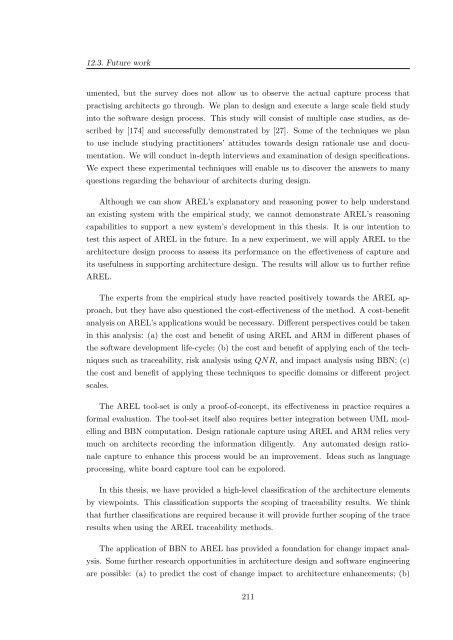A Rationale-based Model for Architecture Design Reasoning
A Rationale-based Model for Architecture Design Reasoning
A Rationale-based Model for Architecture Design Reasoning
You also want an ePaper? Increase the reach of your titles
YUMPU automatically turns print PDFs into web optimized ePapers that Google loves.
12.3. Future work<br />
umented, but the survey does not allow us to observe the actual capture process that<br />
practising architects go through. We plan to design and execute a large scale field study<br />
into the software design process. This study will consist of multiple case studies, as described<br />
by [174] and successfully demonstrated by [27]. Some of the techniques we plan<br />
to use include studying practitioners’ attitudes towards design rationale use and documentation.<br />
We will conduct in-depth interviews and examination of design specifications.<br />
We expect these experimental techniques will enable us to discover the answers to many<br />
questions regarding the behaviour of architects during design.<br />
Although we can show AREL’s explanatory and reasoning power to help understand<br />
an existing system with the empirical study, we cannot demonstrate AREL’s reasoning<br />
capabilities to support a new system’s development in this thesis. It is our intention to<br />
test this aspect of AREL in the future. In a new experiment, we will apply AREL to the<br />
architecture design process to assess its per<strong>for</strong>mance on the effectiveness of capture and<br />
its usefulness in supporting architecture design. The results will allow us to further refine<br />
AREL.<br />
The experts from the empirical study have reacted positively towards the AREL approach,<br />
but they have also questioned the cost-effectiveness of the method. A cost-benefit<br />
analysis on AREL’s applications would be necessary. Different perspectives could be taken<br />
in this analysis: (a) the cost and benefit of using AREL and ARM in different phases of<br />
the software development life-cycle; (b) the cost and benefit of applying each of the techniques<br />
such as traceability, risk analysis using QNR, and impact analysis using BBN; (c)<br />
the cost and benefit of applying these techniques to specific domains or different project<br />
scales.<br />
The AREL tool-set is only a proof-of-concept, its effectiveness in practice requires a<br />
<strong>for</strong>mal evaluation. The tool-set itself also requires better integration between UML modelling<br />
and BBN computation. <strong>Design</strong> rationale capture using AREL and ARM relies very<br />
much on architects recording the in<strong>for</strong>mation diligently. Any automated design rationale<br />
capture to enhance this process would be an improvement. Ideas such as language<br />
processing, white board capture tool can be expolored.<br />
In this thesis, we have provided a high-level classification of the architecture elements<br />
by viewpoints. This classification supports the scoping of traceability results. We think<br />
that further classifications are required because it will provide further scoping of the trace<br />
results when using the AREL traceability methods.<br />
The application of BBN to AREL has provided a foundation <strong>for</strong> change impact analysis.<br />
Some further research opportunities in architecture design and software engineering<br />
are possible: (a) to predict the cost of change impact to architecture enhancements; (b)<br />
211
















